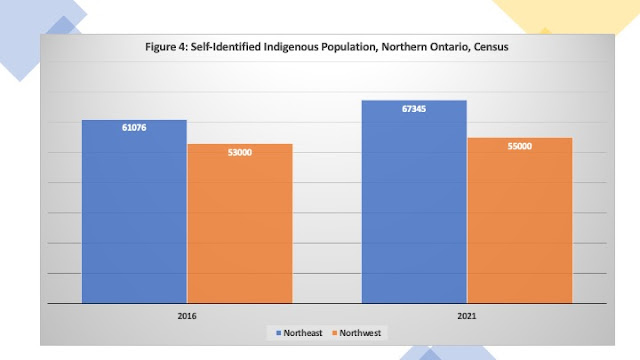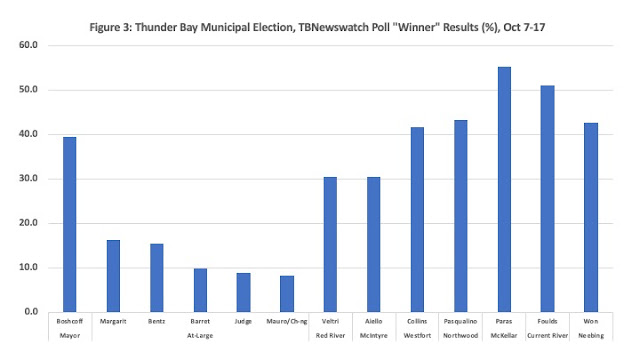By late Monday evening, we will have in place the Thunder
Bay City Council for the next four years and they will need to grapple with an
assortment of issues not least of which will be trying to promote the City’s
economic development. As was noted in a
report released last week, Thunder Bay’s economy has
rebounded from the pandemic but still faces strong headwinds. As the accompanying figure shows, while the
employment declines of the COVID-19 pandemic were the steepest in over a decade, the
recovery appears to have settled us at employment totals that are pretty much
close to the long-term trend of flat long-term performance.

Indeed, Thunder Bay’s rebound in both employment and income
has lagged that of the rest of the province.
Moreover, given that the economy
as a whole is facing higher interest rates and the probability of a recession,
the New Year may not be exceptionally buoyant. Economic growth and expansion of the city’s
tax base is crucial if Thunder Bay is to avoid large tax increases as it seeks
to deal with an assortment of social issues - not least of which is policing - that may indeed prove costly to the
city’s budget.
As a result, it is surprising that there was relatively little
discussion of the economy in this election campaign but perhaps that is because
the local economy is still rather flush with stimulus money from assorted
government initiatives while the City of Thunder Bay enjoyed substantial
government grant revenues and pandemic savings.
This will not last forever especially given that the economy may be
moving into recession. While much of
what happens economically is due to external forces and beyond the direct
purview of the City of Thunder Bay, there are steps City Council can take to
prepare the city to take advantage of opportunity when it presents itself to help
foster economic development and strengthen the local economy.
First, City Council needs to ensure the City of Thunder Bay
develops a reputation for efficient and effective delivery of public services
and infrastructure projects based on outcomes rather than wishful thinking. While a problem before the pandemic, at
present projects are taking even longer to complete than necessary and are very disruptive
to local businesses and residents. For
any businesses considering coming to Thunder Bay, nimbleness on the part of
City projects and services is a positive feature.
Second, City Council will need to be more competitive on the
tax front and that will require providing its existing basket of services with
fewer employees in order to hold the line on taxes. This may indeed prove to be
the most serious immediate challenge the new council faces given that inflation
is high, and wage and cost pressures are immense. Nevertheless, the temptation to simply pass these
costs onto local business and residential ratepayers should be resisted. As part of the process of becoming more
competitive, City Council also needs to cut red tape and facilitate quicker
approval for building and business projects.
Third, the social challenges facing Thunder Bay are an
economic as well as a social issue given that they create an environment that does
not put the City’s best face forward when trying to attract new economic
activity. City Council with the help of
Federal, Provincial, and Indigenous governments needs to effectively tackle
issues that are currently not conducive to attracting business to the City and
these issues include poverty, homelessness, and crime. Despite some of the rhetoric that has been
going on in this election campaign, there is no easy solution to these problems,
but the first step is to recognize that the problem requires a team effort by
all levels of government.
Fourth, there are some bright spots in the City’s economy
that go beyond the stabilization provided by a broader public sector that
employs over 30 percent of workers in Thunder Bay mainly in health and education. City economic development marketing
strategies should focus on sectors with the most growth potential and these
include tourism, mining, and transportation.
The recent success of cruise ship visits to the city while not a panacea
is nevertheless an optimistic development.
Mining support and supply is also a source of future opportunities and
with the trend towards "own-shoring" more economic activity domestically, our
transportation sector – in particular the Port – stands to benefit from
increased activity. As a start, this fall is expected to see a bumper crop of
wheat on the Prairies and given the disruption in global grain markets, Thunder
Bay’s Port should see increased activity.
And finally, looking ahead towards the future, another
looming economic iceberg is the potential for a new out migration wave which may
not be the young but the senior population.
People in the 50 to 65 age range are currently thinking about where and
when they will retire and looking forward many may indeed decide that Thunder
Bay is not the place to live out their golden years. There are many in this age range whose
children have moved away to southern Ontario or further afield, and they thus face
the choice of remaining here in retirement or relocating closer to children. While much is made of the fact that housing
costs a lot in other cities, it is likely going to become more affordable as
prices decline over the next 6 to 12 months.
Wealth and income rise with age and the loss of the
purchasing power of people with substantial assets will not help the local
economy. Weighing in on decisions to
stay or go are the need to downsize accommodation but there is a lack of affordable and
quality apartment and condo housing in Thunder Bay. Cheap and poor design is indeed an issue given Thunder
Bay’s winter climate as there is a surprising lack of indoor parking in many
existing condos in Thunder Bay. Then, there
are the types of services that become more important as one ages especially if
you choose to remain in your own home and here there is relatively poor performance
on things like municipal snow removal.
Massive municipal windrows in your driveway after a storm
aside, the oft-heard mantra that you can retire and stay in your home and get affordable
services as you age is aspirational in Thunder Bay given that residential
services take second place to government contracts and large business projects for
many providers resulting in relatively high-cost services. No one likes a small residential contract
when there are bountiful government and institutional contracts available. This has only grown worse in the post pandemic
labour shortage/inflationary world – for example, the average quote for getting
the exterior of your house painted has literally tripled over the last ten
years. This is well above and beyond where inflation has been over the last decade even
with the pandemic.
As expensive as some think life in other cities in the rest
of Canada is compared to Thunder Bay, there is still a lot more competition elsewhere
that keeps prices and quotes for services in check as well as a better stock of
well-designed housing options for all demographic groups. True, City Council cannot be expected to
single-handedly address Thunder Bay’s business culture and less competitive monopoly
environment. After all, Thunder Bay has
always been a sort of monopoly company town with large employers such as pulp
mills or railways and their economic spinoffs serving as milch cows for local
business - not to mention municipal taxes. We are now a government town,
but City Council can stop adding fuel to the fire by insisting on better value
for money when it comes to the services it purchases.























